|
|
|
Sort Order |
|
|
|
Items / Page
|
|
|
|
|
|
|
| Srl | Item |
| 1 |
ID:
132005


|
|
|
|
|
| Publication |
2014.
|
| Summary/Abstract |
The United States' military-strategic pivot toward Asia is motived by concerns about a rising China, about the increased significance of Asia on the world economic and political stages, and about the growing risks of nuclear proliferation and nuclear first use in that region. Nuclear Asia already numbers five acknowledged or de facto nuclear weapons states among its members: Russia, China, North Korea, India, and Pakistan. Failure to reverse North Korea's nuclear weapons status or political distrust among other powers may increase the number of Asian nuclear weapons states (including states with prospective nuclear-missile reach into Asia) to eight, creating an Asian-Middle Eastern nuclear arms race that defies containment. On the other hand, an alternative presents itself, in the form of a multilateral nuclear arms reduction agreement that would create three tiers of accepted nuclear weapons states and bar the door to new admits.
|
|
|
|
|
|
|
|
|
|
|
|
|
|
|
|
| 2 |
ID:
151894
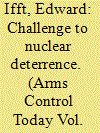

|
|
|
|
|
| Summary/Abstract |
Seventy years into the nuclear age, something revolutionary is about to occur. It is likely that, within the next year or two, a majority of the world’s countries will declare in a legally binding document that they no longer accept nuclear deterrence as a valid concept in international relations.
|
|
|
|
|
|
|
|
|
|
|
|
|
|
|
|
| 3 |
ID:
127633
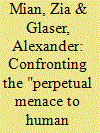

|
|
|
|
|
| Publication |
2014.
|
| Summary/Abstract |
Nuclear weapon states historically have attached great secrecy to their nuclear weapon and fissile material production programs and stockpiles, despite warnings that this would fuel fears, handicap informed debate and decision making, and drive arms races. As evidenced by the "Action Plan on Nuclear Disarmament" agreed upon at the 2010 Treaty on the Non-Proliferation of Nuclear Weapons (NPT) Review Conference, however, the international community now sees greater transparency about nuclear weapon and fissile material stocks as necessary for enabling and monitoring progress toward nuclear disarmament. To support this effort, the International Panel on Fissile Materials has proposed a step-by-step program for weapon states to declare their inventories, production histories, and disposition of nuclear warheads and fissile materials, and to set up joint projects to develop methods for verifying these declarations. This openness initiative is described here, and could be adopted at the 2015 NPT Review Conference, laying a basis for negotiating verifiable deep reductions in nuclear arsenals and their eventual elimination.
|
|
|
|
|
|
|
|
|
|
|
|
|
|
|
|
| 4 |
ID:
131617
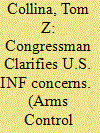

|
|
|
|
|
| Publication |
2014.
|
| Summary/Abstract |
A U.S. congressman provided new details in late April about the Obama administration's allegation that Russia may be breaching a key U.S.-Russian arms control treaty, stating that Moscow may have tested a cruise missile from a prohibited launcher. At a joint April 29 hearing of two House Foreign Affairs Committee panels, Rep. Brad Sherman (D-Calif.) said that Russia claims to have tested an intermediate-range missile for use at sea, which is allowed under the 1987 Intermediate-Range Nuclear Forces (INF) Treaty, but that Moscow used "what appears to be an operational, usable ground-based launcher," which is not allowed. Sherman said that "it appears as if [the Russians] were developing a ground-based capacity for this intermediate missile.
|
|
|
|
|
|
|
|
|
|
|
|
|
|
|
|
| 5 |
ID:
130270
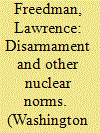

|
|
|
|
|
| Publication |
2013.
|
| Summary/Abstract |
Once the Cold War ended, and with it the prospect of a cataclysmic Third World War, many argued that the nuclear arsenals accumulated during its 45 years were anachronistic and redundant. By the mid-1990s, calls for their complete elimination had gained notable adherents.1 Yet, while elements of these arsenals were removed without much difficulty, their size and destructive power remained substantial and the disarmament movement soon flagged. It took about a decade for it to revive, when in 2007 a surprising group of senior American statesmen refreshed the process.2 Organizations such as Global Zero, which has attracted high-profile support,3 and various international commissions4 echoed their call for a world free of nuclear weapons. This issue impressed itself sufficiently on Barack Obama that he made it the subject of one of his first speeches as President, when he spoke in Prague in April 2009 and committed the United States to the goal of complete nuclear disarmament.
|
|
|
|
|
|
|
|
|
|
|
|
|
|
|
|
| 6 |
ID:
119018
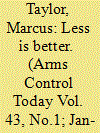

|
|
|
| 7 |
ID:
132204


|
|
|
|
|
| Publication |
2014.
|
| Summary/Abstract |
Recent studies have taken an important first step in examining which terrorist groups, based on their organizational characteristics and the characteristics of the environment in which they operate, are more likely to pursue chemical, biological, radiological, and nuclear (CBRN) weapons. This approach, however, assumes that individuals who perpetrate events act on behalf of the organization to which they primarily belong. Using the case of Jemaah Islamiyah's alleged attempt to develop the pathogenic bacterium Bacillus anthracis, or anthrax, the authors demonstrate the importance of including individual-level variables to the analysis. In particular, the attendance by several key Jemaah Islamiyah members at an Al Qaeda-affiliated training camp is argued to set a chain of events into motion that ended in their involvement in the anthrax cultivation program.
|
|
|
|
|
|
|
|
|
|
|
|
|
|
|
|
| 8 |
ID:
075372
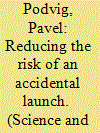

|
|
|
|
|
| Publication |
2006.
|
| Summary/Abstract |
One of the serious risks associated with the strategic nuclear arsenals of Russia and the United States is that an accidental launch might result from a false alarm or from misinterpreting information provided by an early-warning system. This risk will not be reduced by bringing down the number of strategic missiles on high alert to the level of about 500 warheads on each side because this measure will not significantly affect first-strike vulnerability of the Russian strategic forces. Other measures that have been suggested so far, namely an upgrade of the Russian early-warning system, establishing additional channels of real-time exchange of early-warning data, or transparent and verifiable de-alerting of strategic forces, are more likely to increase the probability of an accident than to reduce it. To address the problem of an accidental launch in the short term, the United States and Russia, while continuing to work toward deep reductions of their strategic nuclear forces, should develop and implement measures that would keep their entire forces at low levels of readiness without revealing their actual alert status.
|
|
|
|
|
|
|
|
|
|
|
|
|
|
|
|
|
|
|
|
|